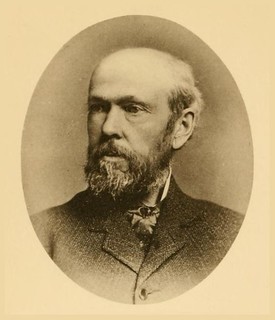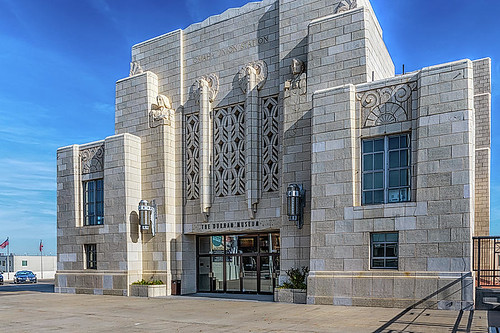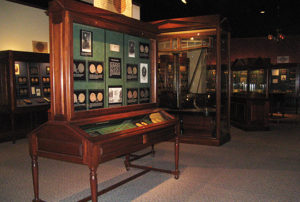
PREV ARTICLE
NEXT ARTICLE
FULL ISSUE
PREV FULL ISSUE
BYRON REED (1829-1891)E-Sylum Feature Writer and American Numismatic Biographies author Pete Smith submitted this article on Omaha collector Byron Reed. Thanks! -Editor Smarty-Pants question of the week: What do Norman Bateman, Frank Collins and Frank Howe have in common? No need to wait until next week to learn the answer. It is revealed in the article to follow.
Byron Reed (1829-1891)
When Byron Reed died, he was the richest man in Omaha. He gave his collection of books and coins to the City of Omaha. That was the end of one story and the beginning of another.
Reed had only an eighth-grade education but taught himself Morse Code. He worked as a telegraph operator in Warren, Ohio. Reed moved to Omaha in 1855, the year the city was founded in what had been Indian territory. He soon ventured into Kansas as a correspondent for the New York Tribune. A pro-slavery lynch mob hastened his return to Omaha. He produced the original survey of the city. He opened the first real estate office in Nebraska Territory in March of 1856. The Byron Reed Company was sold by the family but remains in the property management business in 2023. Reed served as City Clerk from 1860 to 1867; as deputy County Clerk 1861 to 1863; and County Clerk 1863 to 1865. He served on the Omaha City council in 1871 and as president in 1872.
Byron married Mary Melissa Perkins (1845-1943) on April 29, 1862. If my calculations are
correct, he was 33 years, 1 month and 17 days old. She was 16 years, 9 months and 26 days old.
In a 1935 interview she recalled, In 1875, Reed built a home at the corner of Twenty-Fifth and Dodge Streets in Omaha. In 1917, Father Edward Flanagan rented the boarding house there as his site for the Father Flanagan Home for Boys. Withing two years, they outgrew the property for what would become Boys Town. Reed surveyed and laid out residential subdivisions and became wealthy through his investments in real estate. He acquired property around what would be the Prospect Hill Cemetery and donated it to the city. Reed was appointed by President Harrison to serve on the Assay Commission in 1890. Omaha's richest man became ill and died at home in Omaha on June 6, 1891. He is buried in Prospect Hill Cemetery on land he donated to the city. Also buried there is his wife Mary Melissa Perkins Reed ((1845-1943), his son Abraham Lincoln Reed (1865-1952) and daughter-in-law Thede Adeline Capron Balch Reed (1873-1946). Byron's father, Alexander, was a collector of coins and books. Byron extended the collection to include examples of almost all United states coins issued through his death in 1891. He also collected rare books, manuscripts and autographs. Reed's will provided funds to build a city library, art gallery and museum at 1823 Harney Street and donated his collections to be preserved at that library. The history of the collection is as complicated and interesting as the life of Reed. The exhibit was within a museum on the second floor of the new library building. It was initially a popular attraction for visitors. It soon became a popular attraction for thieves. The exhibit opened to the public on April 30, 1895. In December of 1895, burglars came through a window and broke a panel in the door before being scared off by alarms. In 1898 a man secreted himself in the building overnight. He failed to gain entry to the collection room and killed himself with a pistol shot in the morning before he was discovered. In one case the alarm worked properly but the telephone company delayed in reporting to the police and the police delayed their response to the scene. That burglar was not apprehended. In 1900 an attempt was made to rob the collection. The attempt failed when Frank Howe sawed through a padlock, set off an alarm and was quickly arrested. In 1907 a thief overpowered a night watchman in a struggle and made off with 103 recent coins worth $146.66. In February of 1908, burglars broke into the adjacent Boyles College building and attempted to span the ten-foot gap between the two buildings with a ladder. The ladder was too short and the plot abandoned. In 1909 Norman Bateman was convicted of attempting to rob the collection and sentenced to twenty days in custody. He was in possession of a wood rasp used to pry open a case. He claimed that there was an innocent explanation and he used the rasp to comb his hair. On January 2, 1930, an ambitious burglar possibly named Frank Collins broke through a basement window, pried open an iron screen, broke through an iron grating and drilled holes through a wooden door. He set off an alarm when he reached through to unlock the door. Under his real name of S. H. Fisher, he was sentenced to two years in prison. In 1955, the American Numismatic Association held their annual convention in Omaha with the encouragement of Omaha resident and president of the ANA, Dr. J. Hewitt Judd. No burglary attempts were noted during the convention. In 1963, a man ran from the building with police in pursuit, He left a set of burglar tools behind. In August of 1963, three men tied up three employees and a police officer on the third floor. They were thwarted by a steel door and left behind burglary tools when scared off by an alarm. In March of 1965 it was reported that the American Numismatic Association would build their headquarters next to the Joslyn Museum in Omaha. One proposal was to loan the Reed collection to the ANA. It is my understanding that the ANA headquarters was built somewhere else. In May of 1965, thieves cut a hole in the wall of the Byron Reed room at the library. They were surprised by the building engineer and fled. Had they stuck around, they would have discovered that the collection had been removed from the library and placed in a bank vault. While Reed had donated land for the library and donated his collection to the library, he left no endowment to cover costs of security. The collection was underutilized and poorly managed. Items disappeared and others were switched for lower quality examples. City officials saw the security costs as a drain on their resources while a sale would be a great boost to their resources. Melvin Stark was numismatic curator for the Boys Town museum. He was a volunteer at the library producing an inventory of the Reed collection. In 1972 the city council attempted to sell the collection to raise money for a new library. Melvin Stark alerted the numismatic community and fought the sale. In 1985 the city transferred the collection to the Durham Museum. In 1996 the city sold off parts of the collection through an auction by Spink. The sale realized $5.8 million with three million going to the Durham Museum and the rest to the city. In 1978, a successful break-in was made at the U. S. National Bank vault where the Reed collection was stored. ANA President Grover Criswell was in town and wanted his picture taken with the mayor and some of the Reed coins. The vault door required two combinations, one held by the Byron Reed Historical Association and the other under the care of City Council representative Richard Takechi. When called on to open the safe, he could not remember the number. A locksmith was called and the safe was drilled open.
Takechi said that for security reasons, it should not be known that he had one of the
combinations. When asked what happened, he said, In 1986 the city council approved an agreement to loan the Byron Reed Collection to the Omaha History Museum. The surviving collection was put on display at the Durham Western Heritage Museum in the art deco Union Station at 801 South 10th Street. Dr. Larry Lee mounted the exhibit while he was curator there. The exhibit was opened in 1999.
Less than a year later, on April 6, 2008, the name was changed to the Durham Museum. While the ANA Museum tells the story of coinage to the general public, I found the Durham Museum more interesting. It includes an exhibit of numismatic literature and extensive exhibits of great coins and tokens. I highly recommend it.
Wayne Homren, Editor The Numismatic Bibliomania Society is a non-profit organization promoting numismatic literature. See our web site at coinbooks.org. To submit items for publication in The E-Sylum, write to the Editor at this address: whomren@gmail.com To subscribe go to: https://my.binhost.com/lists/listinfo/esylum All Rights Reserved. NBS Home Page Contact the NBS webmaster 
|



